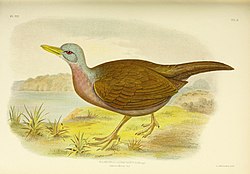| Chestnut rail | |
|---|---|
 | |
| Scientific classification | |
| Kingdom: | Animalia |
| Phylum: | Chordata |
| Class: | Aves |
| Order: | Gruiformes |
| Family: | Rallidae |
| Genus: | Gallirallus |
| Species: | G. castaneoventris |
| Binomial name | |
| Gallirallus castaneoventris Gould, 1844 | |
| Synonyms | |
Eulabeornis castaneoventris | |
The chestnut rail (Gallirallus castaneoventris) is a species of bird in the family Rallidae. It is found in the Aru Islands and northern Australia. Its natural habitat is subtropical or tropical mangrove forests. It was formerly the only species placed in the genus Eulabeornis.
Their nests are shaped into platforms and range in size from 35–50 cm in diameter, and 5–10 cm in depth. They are built in mangrove trees out of predominantly mangrove sticks, along with some leaves and seedlings. [2] Clutch size ranges from 2-4 eggs per brood.

